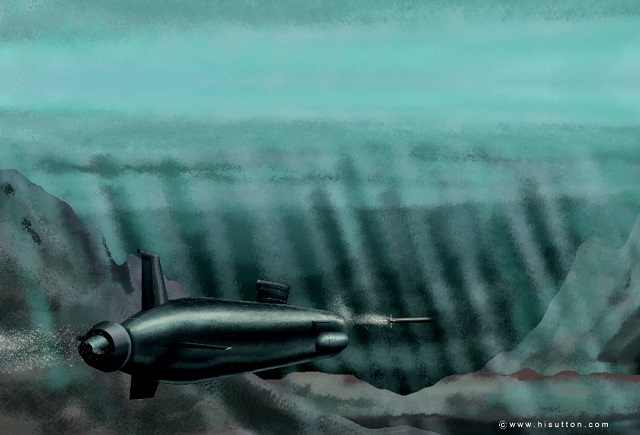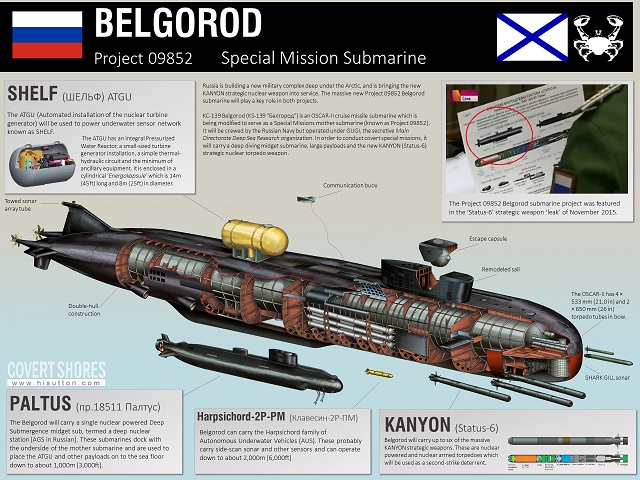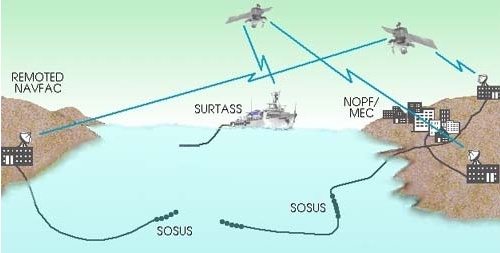|
|
|||
 Artist impression of Project 09851 submarine Khabarovsk. Image via covert shores. Artist impression of Project 09851 submarine Khabarovsk. Image via covert shores. |
|||
|
|
|||
|
A detailed description of the work can be found in open sources. The Garmoniya’s key element is the robotized self-contained seabed sonar set up covertly by special submarines. Deep below the surface, the sonars extend their fixed multi-element and seabed hose antennas, the latter being many meters long. The sonars conduct passive surveillance, trying to detect the characteristic noises made by ships and aircraft. The sonar stations also can go active to ping and classify surface and submerged targets. Several sonars are merged into a network capable of developing the situation on the surface and under water in an area measuring hundreds of square kilometers.
The control equipment of the seabed sonar processes the information gleaned by the sensors and transmits it to the control center. For this purpose, the station has a special retractable radio buoy that surfaces and uplinks the data to communications satellites. The power supply of the sonar is in the form of unique lithium-ion polymer batteries fitted with the control and monitoring system. The batteries maximize the adaptation of the power supply to the seabed sonar’s operating modes. Measuring just a little longer than 30 cm, a single battery has a rated capacity of 28A/h and a rated voltage of 58-80V. The power supply operates within the -10°C…+45°C temperature bracket. On order from the control center, the seabed station retracts its antennas, releases the comms buoy and gets back to the submarine. |
|||
|
|
|||
 Artist impression of Project 09852 Belgorod. Image via covert shores. Artist impression of Project 09852 Belgorod. Image via covert shores. |
|||
|
|
|||
|
"The Sarov special submarine can carry self-contained robotic seabed sonars of the type," military expert Dmitry Kornev says. "There have been reports of the Sarov’s involvement in the testing of some submersible robots. Judging by photos of the submarine, she is loaded with cylindrical items several meters long, which are retrieved after the tests by the Zvyozdochka vessel using special deep-water manipulators. Most likely, the diesel-engined Sarov will be replaced further down the road by the nuclear-powered Belgorod and Khabarovsk, which construction has begun. The two boats have been mentioned along with the Sarov as underwater robot-carrying platforms several times."
The Sevmash Shipyard laid down the Project 09851 Khabarovsk submarine in Severodvinsk in July 2014. She is to be commissioned for Russian Navy service not later than 2020. The Project 09852 Belgorod special submarine, which has been converted from a Project 949 (NATO reporting name: Oscar) ‘boomer’, will be delivered in the near future. "The information about the Khabarovsk is scarce," Kornev says. "Even its appearance is unknown. There is more information on the Belgorod. She will carry deep-water self-contained manned and unmanned rescue submersibles. Officially, she is designed for research in remote areas of the ocean and search-and-rescue operations." "Seabed sonars are rather pricey. Hence, they will be reusable," military expert Dmitry Boltenkov says. "Special shops are needed to maintain them. Not only their batteries can be replaced there, but their sophisticated electronics and mechanical units can be checked too. A minor failure may end up in the loss of an expensive seabed sonar." Presumably, Russian Navy personnel will service and prepare robotic sonars for missions on the premises of the ocean surveillance robot preparation shop. In addition to an outsized-hardware storage facility, the premises will include a boiler house, a power plant, a sewage purification system and fuel oil storage tanks. The security provisions include a checkpoint, an observation tower, a vehicle inspection ramp and a guardhouse. According to Izvestia, the Garmoniya’s control center will be on Novaya Zemlya. In addition to the main building, the facility will comprise a five-parking-space storage and a checkpoint. "Probably, there have been Sarov-tested finished seabed sonars," Boltenkov told the Izvestia daily. "There also is a temporary control center and a sonar maintenance shop. Therefore, the Garmoniya will achieve its initial operational capability in 2017. Given the pace of the construction in Severomorsk and on Novaya Zemlya, and the delivery date of the Khabarovsk, the system will be fully deployed in 2020, presumably." © Copyright 2017 TASS. All rights reserved. This material may not be published, broadcast, rewritten or redistributed. |
|||
Russian Military Deploying SOSUS-like global Maritime Surveillance System named Garmoniya
- Posted On











